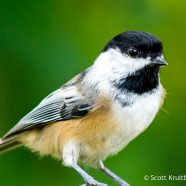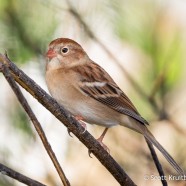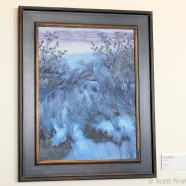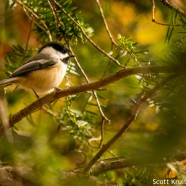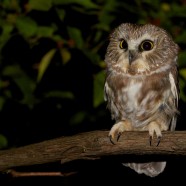Black-capped Chickadee
The Black-capped Chickadee (Poecile atricapillus) is as familiar a backyard resident as can be, but did you know these birds migrate, too? Well, some of them anyway, in a particular way. Young birds move south and irrupt during certain years based on the reproductive success of the summer and the local conditions. The best way to see this is finding a number of them in migratory hotspots in the autumn. If you are at an area such as a beach along the shore of Lake Erie where you typically find zero and suddenly see a flock of six or eight, there you go. I have seen up to 18 in a little flock...
Read MoreField Sparrow
This Field Sparrow (Spizella pusilla) actually flew directly towards me and my dog to perch on this white pine branch this morning. It looked us over for a minute and then went back to snacking. It is another great example of a lovely bird that we can still find even in the..uh, cold days of November? It is November, and apart from the low sun angle and early sunset it felt like it could have been late August out there today. This will undoubtedly keep birds with us a little longer with easier to survive temperatures, poor migratory conditions because of the southerly flow, and prolonged...
Read MoreSnowy Owl Art
Whoa, it is COLD out there! What month is this again? It feels like we went from summer to winter almost overnight. Regardless of the extreme temperature departures on both sides of the spectrum, next month is already the time to start thinking about Snowy Owls showing up in our region. Every year some of the species irrupts south into the continental United States, but the question is always how many young successfully fledged in the breeding season and how many decide to take a journey to see us. Until then you can come and enjoy some Snowy Owls on our walls in the Art and the...
Read MoreBlack-capped Chickadee (Poecile atricapillus) irruption
There have been Black-capped Chickadees (Poecile atricapillus) moving south in very subtle ways for a couple of months now. If you watch migratory hotspots you can sometimes detect their irruption years, especially if that location is not a particularly friendly habitat for the species. I have seen flocks of 10-20 birds tightly packed together and feeding on the move, possibly heading for a feeding station like yours. I always wonder what particular triggers end up notifying a widespread and highly adaptive bird like this one that they should nonetheless change their quarters for the autumn...
Read MoreNorthern Saw-whet Owl (Aegolius acadicus)
This tiny bundle of Halloween fear and dread was photographed by RTPI Affiliate Sean Graesser as he had a very successful night of netting and banding Northern Saw-whet Owls (Aegolius acadicus) earlier this week in New Jersey. They are definitely on the move well now in the Mid-Atlantic.
Read More



